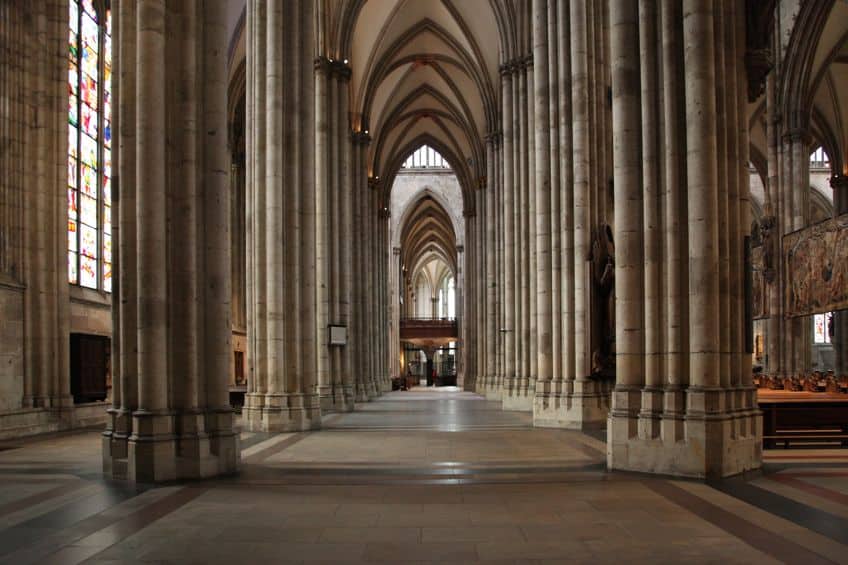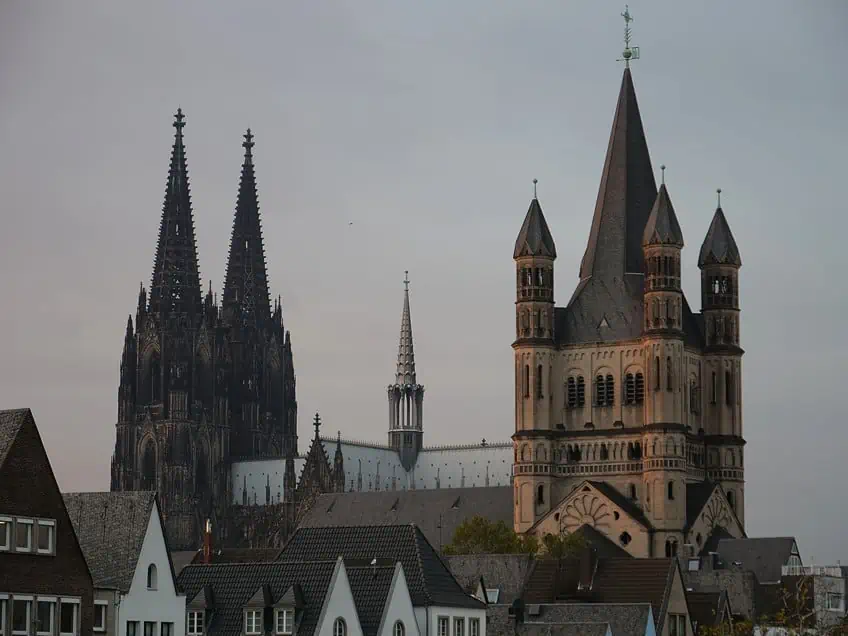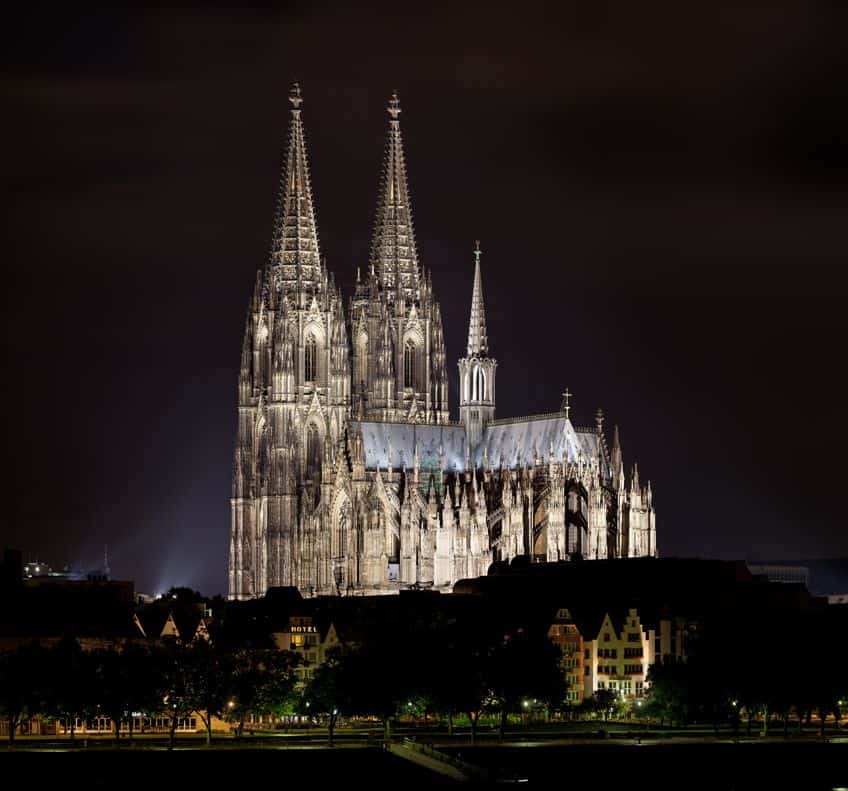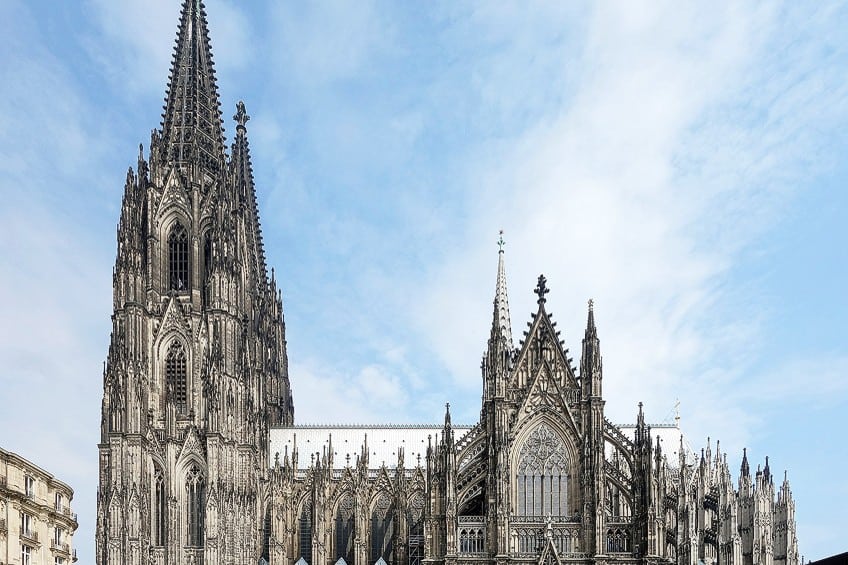Cologne Cathedral – The History of Germany’s Koelner Dom
Cologne Cathedral, known as Kölner Dom in German, is a Gothic cathedral in Germany that has quite a remarkable history behind it. This article will examine the characteristics of the cathedral, some of the artifacts that are housed within its walls, the history of the structure, and end off with a few additional Cologne Cathedral facts. So, keep reading if you want to learn a lot more about the Cologne Dom!
A Look at Cologne Cathedral
| Architect | Master Gerhard (1210 – 1271) |
| Date Constructed | 1248 – 1560 and 1842 – 1880 |
| Function | Church |
| Location | Cologne, Germany |
Cologne Cathedral, known as Kölner Dom in German, is a Catholic cathedral located within Cologne. This church has gone on to become the largest church in Northern Europe and one of the largest in the world. With its twin spire design, the Cologne Cathedral is a dominating aspect of the Cologne skyline, and it attracts far more visitors than one may expect. This Cologne Dom is an utterly magnificent sight with quite a long and interesting history behind it.
Additionally, it is one of the tallest churches in the world. So, it’s about time we had a look at this magnificent structure and examined a few things about it.
The Characteristics of Cologne Cathedral
Cologne Cathedral is a classic example of Gothic architecture. It was also based quite closely on Amiens Cathedral in France. The basic layout of this cathedral design is in the form of a Latin Cross, as was standard for Gothic cathedrals at the time. There are two aisles in the Cologne Cathedral interior, and it has some of the highest vaults in the world.
It also makes use of flying buttresses to aid in the extension of the height of the building, and these flying buttresses show the French Gothic influences of the building.
This Cologne Germany cathedral consists of a medieval-style choir with even more French influence, the windows make use of sophisticated tracery, and the nave retains its 19th-century stained-glass windows. The interior of this cathedral is utterly gorgeous, but otherwise fairly standard for what was expected of Gothic cathedrals at the time. It is majestic and massive, and it draws the eyes upwards. The many windows allow the filtering of light through the structure, and all of this allows the Shrine of the Three Kings to especially stand out.
 Cologne Cathedral viewed from below, Germany (1880); Adam Jones, Ph.D., CC BY-SA 3.0, via Wikimedia Commons
Cologne Cathedral viewed from below, Germany (1880); Adam Jones, Ph.D., CC BY-SA 3.0, via Wikimedia Commons
The exterior of the structure is definitely more famous than the interior though. This Cologne Dom is known for its strikingly large spires. These spires are absolutely massive in scale and at 157 m (or 515 ft) in height, they turn this German cathedral into the tallest two-spired church in the entire world. It is also the second-tallest church in Europe, but this is not the only honor it has attained as it also holds the more international record as the third-tallest church in the world. Basically, Kölner Dom is a gargantuan structure that is still massive by modern church standards. Perhaps not quite as impressive as a skyscraper’s height, but the comparison would be a bit of an unfair one.
So, the spires are positively massive in scope, but the finials are also a famous addition. The finials are the tops of the spires, and these finials are made up of a central shaft that is surrounded by an array of wreaths that wrap around it.
These wreaths are also of different sizes which lend some level of asymmetrical design to an otherwise very symmetrical structure. However, these finials were not universally loved when they were created, and they had to be somewhat reworked after they’d been unveiled to the public. They were eventually accepted, and to this day you can visit a copy of the finials on the western side of the structure. This copy of the finials is made out of concrete though but allows regular people, who can’t exactly climb to the top of a cathedral, a chance to examine the kind of intricacy that is otherwise reserved for an immense and inaccessible height.
The Relics Within Cologne Cathedral
There are many relics within Cologne Cathedral. Inside the walls of this gloriously massive structure are three very important items. The first of these three items is, by far, the most important one: the Shrine of the Three Kings. This is an immensely important holy relic because, while the actual reliquary, or container, is not a holy relic and was only built by Nicholas of Verdun in 1180 – 1225, the reliquary contains something of extreme importance. The inside of this holy container is the resting place for the bones of the Biblical Magi, also known as the Three Wise Men, who visited Jesus Christ when he was born.
The reliquary is designed out of bronze and silver alongside gemstones and decorative sculptures arranged in the shape of a basilica. The container for such an important relic clearly needed to be an illustrious item worthy of supreme respect, and it certainly is a gorgeous thing. In addition, while holy relics should be treated with some level of skepticism, it has been confirmed that bones and pieces of clothing are present within the reliquary.
The reliquary is now set on a shrine within the Cologne Cathedral interior, and it can be visited, and it is visited by millions of people every year. The reliquary itself is also a magnificent sight, and it is the largest such reliquary in the Western world and has been considered to be the high point of Mosan artwork. It’s a beautiful piece of art and it has remained through the conflicts that struck Cologne during the Second World War.

Aside from this holy relic, there are also two other major items of note within the cathedral. The Gero Crucifix is one of them. This is a large oak crucifix that still contains some traces of paint and gilding, and it is the largest crucifix on this side of the Alps, It is also the earliest known free-standing sculpture of its kind from the medieval period. It was constructed as far back as 965 – 970 and it still stands within Cologne Cathedral’s interior.
The other major item within the cathedral is the Mailänder Madonna. This is a High Gothic carving of the Virgin Mary with the baby Jesus. So, it is a fairly typical image of the Madonna, but it was constructed in around 1290 and has remained standing to this day. It is also a wooden carving.
So, it has managed to remain intact for centuries despite going through the same ordeals as the structure in which it is housed.
The History of Cologne Cathedral
Much like many other cathedrals of its type, Cologne Cathedral was not built atop fresh land that had never been touched before. Instead, the land had been used by humans for some time before the present cathedral was finally constructed. At its earliest points, it appears that the area may have been used for grain storage, which is less illustrious, and later a Roman Temple, which is a little more illustrious, However, the region was occupied by Christian buildings as early as the 4th century CE.
These Christian structures would have included the oldest cathedral on the spot, but such cathedrals existed so long ago that they tend to be utterly absent from the present day.

Then there was a second cathedral built in Cologne in the 9th century, and there are actually some pieces of it still remaining underneath the current cathedral. However, as was staggeringly common for old cathedrals, this second one burned down in 1248. This was the thing that finally cleared up the land for the cathedral that stands to this day.
The Medieval Origins of the Cologne Cathedral
The medieval period, also known as the Middle Ages, was a lengthy period of time in which many developments in European architecture occurred. This is where the Gothic style comes into play, and so construction started on the Cologne Cathedral. Inside this new cathedral, there would need to be space for a certain holy relic that was attained by the Archbishop of Cologne, Rainald of Dassel, in 1164. These relics have already been discussed in some detail and are the supposed relics of the Three Kings who visited Jesus Christ on the day of his birth and gifted him with various items.
A relic of such importance would need to be properly stored, and so that was what Cologne Cathedral needed to be. It needed to be a strong, sturdy structure that was also suitably majestic so that it could exhibit such an important item for all to see.
They knew that because of this relic, this cathedral would become a place of pilgrimage. So, they needed to design a structure befitting of such a task. The foundation stone was officially laid on 15 August 1248 and construction began in earnest. The eastern arm of the structure was completed first and was consecrated in 1322, and this allowed the site to be temporarily sealed off and used as a church and storage place for the relic while the construction continued. This cathedral would take an exceedingly long time to construct, so they couldn’t exactly wait around forever for it to be built in its entirety before they started using it. This Cologne Germany cathedral would soon become a place of pilgrimage.

Work continued until the mid-14th century but then things started to slow. Primary construction came to an end in 1473 because there simply weren’t enough funds to continue the project anymore. There was some sporadic construction here and there, but even that came to an end in 1560. Cologne Cathedral was left in this state for centuries, and the construction crane used for the cathedral building remained up there too.
It became part of the Cologne skyline for over 400 years. Work would eventually need to resume.
The Eventual 19th Century Resurgence of the Cologne Cathedral
Cologne Cathedral remained untouched for hundreds of years. It just sat there. Then there was a bit of change in Europe in the 19th century. There started to be a renewed interest in the Middle Ages in general. This was also helped along by the discovery of the façade’s original plan. The people wanted their grand cathedral constructed, and so a fundraising effort began that managed to accumulate two-thirds of the necessary funds from the people. The Prussian state handed over the rest of the costs.
This new fervor over the cathedral would lead to new work being done, and construction officially resumed on this ancient structure in 1842.
None of the original builders or designers of this building would ever see it come to life, but these new builders would. In addition, thanks to technological improvements in building techniques since the church had initially ceased construction, the cathedral was much faster to assemble.

Cologne Cathedral was officially completed in 1880 and its completion was celebrated across Germany. This was because Cologne Cathedral was now the largest cathedral in all of Germany, and it had only taken 632 years to finish the project! It stood at a height of 157.38 m (or 516.3 ft) and that made it, for a total of four years, the tallest building in the world (it was superseded by the Washington Monument in the United States). It may have taken a good few years, but Cologne Cathedral was finally done, and now that it was done, it could stand as a landmark in Cologne for the remainder of its existence.
This is an existence that persists to this day, but there were some new complications for Cologne Cathedral. WW2 happened, after all.
Complications During the Second World War for Cologne Cathedral
The Second World War was not particularly pleasant for this cathedral in the middle of Germany. Once the attacks had been turned on the German state, this Gothic cathedral sustained significant damage as it sustained fourteen separate aerial bomb hits. It was badly damaged, but the Cologne Cathedral interior ultimately managed to survive alongside the exterior.
For instance, the two famed spires never collapsed and were then actually used by Allied pilots as a navigational landmark, which somewhat adds insult to injury.
Then there was a small battle on 6 March 1945 just west of the cathedral. This battle took place between American and German tanks, and a tank was captured on film right beside the cathedral, with the spires in view, as it managed to take down two American Sherman tanks and a few American troops. The tank was soon destroyed, but it remained on display outside the cathedral for the rest of the war.

The Second World War eventually came to an end, and while the area around the cathedral was utterly decimated, the cathedral itself managed to survive the whole ordeal. Repairs started soon after the battle and continued until 1956. There was also an interesting little addition when it came to those repairs because some poor-quality bricks were taken from a building nearby and used for the repairs.
These bricks were visible on one of the towers until 2005, and they remained there as a reminder of the war but was eventually restored using higher-quality construction materials to return it to its original state.
Additional Work in the 21st Century on Cologne Cathedral
Cologne Cathedral continued its existence as a place of pilgrimage throughout the 20th and 21st centuries, and there was even some new work done on the structure in 2007 as a new stained-glass window was added. This new artwork was paid for through donations, and this was a digitized design that was made to resemble a carpet.
The reason for the new addition was because the original glass had been destroyed in the Second World War and had been occupied by plain glass ever since.

So, the new stained glass was installed but it received some criticism, including from the archbishop of the cathedral at the time, but it has ultimately remained in place. The Cologne Cathedral continues, to this day, to serve as a destination for many religious and non-religious visitors who wish to see the gloriously tall Gothic architecture on display and the relics housed within its walls. This will likely continue to be the fate of this cathedral for generations to come.
Some Additional Cologne Cathedral Facts
Let’s have a look at a few extra Cologne Cathedral facts. This is a magnificent example of Gothic architecture and so there is always a lot more to learn about structures of this variety:
- The two spires of Cologne Cathedral are not equal. The northern tower is actually taller than the southern tower. The difference is not perceptible to most people as it’s only a 7 cm difference, but regardless of all the planning that was done, they aren’t even.
- Cologne Cathedral is situated near the train station. This means that this magnificent Gothic cathedral is one of the first things you see as soon as you enter the city. It, therefore, serves as a fantastic landmark for those who need to navigate Cologne.

- Cologne Cathedral is the most visited landmark in Germany. The site accommodates up to six million visitors a year. This may be due to the holy relic within its walls that serves as a pilgrimage point.
- Cologne Cathedral saw damage in the Second World War. There were bombs dropped throughout the city and specifically on the cathedral, and while the surrounding area was razed to the ground, the same was not true of one place: Cologne Cathedral. WW2 led to the damage of many structures, but at least this cathedral survived the destruction.
- The old church is not actually a black stone construction. Cologne Cathedral was made using sandstone, and it mixed with polluted rain to become its present color. It requires constant cleaning because of it, but as soon as cleaning is done, it restarts.
These have been just a few Cologne Cathedral facts. Kölner Dom is quite a fascinating structure, and it deserves all the attention that it receives. There are doubtlessly more interesting facts about this Gothic cathedral, but there’s not enough time today to go through them all.
We have come to the end of our discussion about Cologne Cathedral. Kölner Dom, as the structure is known in Germany, is the most prominent landmark in the entire city of Cologne and can be seen from practically every direction in the famous German city. We have examined the cathedral’s characteristics, the relics within its walls, its history, and we even ended off with a few additional Cologne Cathedral facts. So, hopefully, you learned a few things along the way. All that’s left to say is that we wish you a great day/week/month ahead!
Frequently Asked Questions
Where Is Cologne Cathedral?
Cologne Cathedral is, as the name suggests, located in Cologne. Cologne is the largest city in North Rhine-Westphalia, a western state in Germany. It’s a highly populous location and home to nearly 4 million people in the city and its urban surroundings. Cologne Cathedral is the most famous medieval landmark in the city.
What Architectural Style Does Cologne Cathedral Adopt?
Cologne Cathedral makes use of the Gothic architectural style. This is a form of late medieval architecture that followed on from the earlier Romanesque style, and is characterized by its use of thin walls, ogival or pointed arches, massive height, stained-glass windows, and ornamental construction. It would eventually be replaced by Renaissance architecture as the dominant form of architecture in Europe.
Why Did Cologne Cathedral Remain Unfinished for So Long?
To state the answer to this very simply: they ran out of money. Constructing a cathedral is a lengthy project that can sometimes take centuries. This means that those who are funding the project need to be able to maintain the constant flow of wealth necessary to maintain construction of this variety. This is why many cathedrals are built using royal or church money. Cologne Cathedral’s construction was eventually restarted in 1842 after interest in structures of this variety became prominent again, and funding was able to be reattained through both individual donations and a government payout.
Justin van Huyssteen is a writer, academic, and educator from Cape Town, South Africa. He holds a master’s degree in Theory of Literature. His primary focus in this field is the analysis of artistic objects through a number of theoretical lenses. His predominant theoretical areas of interest include narratology and critical theory in general, with a particular focus on animal studies. Other than academia, he is a novelist, game reviewer, and freelance writer. Justin’s preferred architectural movements include the more modern and postmodern types of architecture, such as Bauhaus, Art Nouveau, Art Deco, Brutalist, and Futurist varieties like sustainable architecture. Justin is working for artfilemagazine as an author and content writer since 2022. He is responsible for all blog posts about architecture.
Learn more about Justin van Huyssteen and about us.
Cite this Article
Justin, van Huyssteen, “Cologne Cathedral – The History of Germany’s Koelner Dom.” artfilemagazine – Your Online Art Source. April 21, 2023. URL: https://artfilemagazine.com/cologne-cathedral/
van Huyssteen, J. (2023, 21 April). Cologne Cathedral – The History of Germany’s Koelner Dom. artfilemagazine – Your Online Art Source. https://artfilemagazine.com/cologne-cathedral/
van Huyssteen, Justin. “Cologne Cathedral – The History of Germany’s Koelner Dom.” artfilemagazine – Your Online Art Source, April 21, 2023. https://artfilemagazine.com/cologne-cathedral/.



